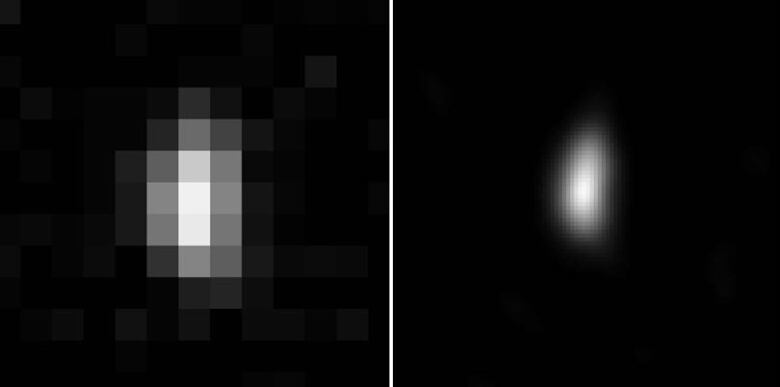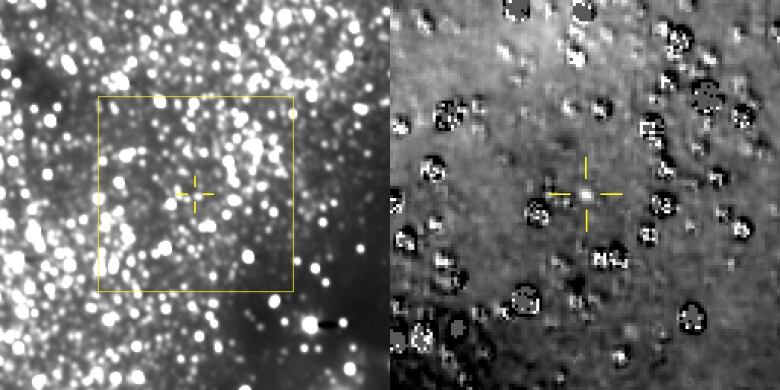NASA's New Horizons spacecraft to reach icy world at edge of solar system New Year's Day
Getting to a celestial body more than 6 billion km away and just half the size of Fort McMurray isn't easy

New Horizons, the spacecraft that provided the first glimpse of distant Pluto, is about to shed light on another world, a small icy body 6.5 billion kilometres from Earth.
On New Year's day at 12:33 a.m. ET, the spacecraft will fly by 2014 MU69, given the informalnameUltima Thule, a 30-kilometre-wide object that is part of the Kuiper Belt. The region is a disk of icy objects beyond the orbit of Neptune.
It will be one of the most distant regionsever visited by a spacecraft.
"We're on Ultima's doorstep," said Alan Stern, New Horizons'principle investigator from Southwest Research Institute, a Texas-based non-profit organization. "We've never seen any Kuiper Belt object up close. We don't have any idea of what their geology is like, how evolved they are, how they were constructed, even what they're made of."
The spacecraft sent back some early images today that hint at Ultima's shape.

UltimaThule is sofar away that it will be 10 hours before flight controllers at Johns Hopkins University's Applied Physics Laboratory in Laurel find out whether the probe survived the flyby.
A few black and white pictures of Ultima Thule might be available following that official confirmation, but the highly anticipated closeups, in colour it's hoped, won't be ready until Wednesday or Thursday.
The spacecraft flew past Pluto, once considered our ninth planet and now considered a dwarf planet and part of the Kuiper Belt, in July 2015. Stern vociferously opposes the decision to reclassify Pluto.
Unravelling its secrets
When New Horizons flew past Pluto a much larger worldthan Ultima Thule at 2,380 km in diameter it revealed things that planetary scientists could previously only theorize about.
Some of the findings included: Pluto has been geologically active in the recent past; it has a thicker atmosphere than expected (and it's blue); and it is home tomoving nitrogen glaciers and floating ice mountains.

When New Horizons whips past Ultima Thule at 14 km/son Jan.1, it will be just 3,500 kilometres above its surface providing images in much higher resolution than even those taken of Pluto.
Stern is hoping for more surprises.
"We're going to look for rings. We're going to look for [moons]. We're going to see if it has an atmosphere," Stern said. "So it's a lot about composition and geology and how the thing was built. How [did]these building blocks of planets get made 4 billion years ago. This is the most well-preserved sample of that era, of planet formation, anyone's ever been to."
The only other object has been Pluto but, Stern noted, it has undergone geological evolution so is not preserved at all.
"Ultima is our first and for now our only chance to really get at a time capsule of the formation era of the planets," he said.
Challenges
Getting to a celestial bodymore than six billion kilometres away and just half the size of Fort McMurray is no easy task.
"Ultima is 100 times smaller than Pluto, so it's 10,000 times fainter," Stern said. "This means that it's much harder to navigate to, to track on and home in on, by a lot."
After choosing Ultima Thule out of several potential candidates, the Hubble Space Telescope helped scientists track the object so they could fire the engines of New Horizons and change its trajectory. Now that it's closer, they can track it with the onboard camera.

But tracking it wasn't the only challenge: because the spacecraft is so distant, there is less light to keep the instruments warm, so they are under more strain. As well, it's much further away from Earth.
"Communications time has gone from 4 hours each way to six hours each way. That's a 12-hour round trip," Stern said. "We're playing a chess game where every move takes 12 hours, by remote control with something [6.5 billion kilometres away] and no backup."
Stern is excited at the prospect of finding another target to which they can send New Horizonsfollowing its visit to Ultima Thule.
"The mission has been an unbelievable experience and a resounding success," Stern said.
The public is invited to take part in the mission by sending a message to Ultima Thule.












_(720p).jpg)


 OFFICIAL HD MUSIC VIDEO.jpg)
.jpg)



























































































